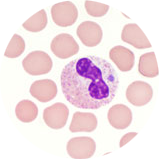Anaplasmosis is a tick-borne disease caused by the bacterium Anaplasma phagocytophilum. The bacterium was previously known by other names, including Ehrlichia equi and Ehrlichia phagocytophilum, and the disease was previously known as human granulocytic ehrlichiosis (HGE).

Anaplasma phagocytophilum inside a white blood cell. Photo: Centers for Disease Control and Prevention.
- Transmission
The bacteria that causes anaplasmosis is transmitted in Indiana by the bite of a blacklegged tick (Ixodes scapularis). In rare cases, the bacterium may be transmitted by blood transfusion.
- Signs and Symptoms
Signs and symptoms of anaplasmosis typically begin within 1–2 weeks after the bite of an infected tick. People in the early stages of illness can experience mild to moderate flu-like symptoms, such as:
- Fever and chills
- Severe headache
- Muscle aches
- Nausea, vomiting, diarrhea, or loss of appetite
Rarely, if treatment is delayed or if there are other medical conditions present, severe illness can occur. Signs and symptoms of severe illness can include respiratory failure, bleeding problems, organ failure, and death. People over the age of 50 and those with weakened immune systems are more likely to develop serious illness.
- Diagnosis
Diagnosis of anaplasmosis is based upon the patient’s signs and symptoms, a history of possible exposure to ticks, and appropriate laboratory testing. Early recognition of symptoms is important for prompt diagnosis and treatment. If you think you have anaplasmosis, contact your health care provider right away.
People who have removed an attached tick sometimes wonder if they should have it tested for tick-borne diseases. Although some laboratories offer this testing, IDOH does not recommend it. If the tick tests positive, it does not necessarily mean that you have been infected; if the tick tests negative, it may provide a false sense of security because you may have been unknowingly bitten by a different tick that was infected.
- Treatment
Doxycycline is the treatment of choice for adults and children of all ages with suspected anaplasmosis. Doxycycline is most effective at preventing severe complications and death if it is started early in the course of illness. While post-tick bite antibiotic prophylaxis is not recommended to prevent anaplasmosis, treatment should be started for anyone with suspected anaplasmosis (patients with a compatible clinical illness) and should never be delayed while waiting for laboratory results.
- Prevention
The best way to prevent anaplasmosis is to avoid tick bites. Please see our tick prevention page for more information.
For more information about anaplasmosis, please visit the CDC Anaplasmosis webpage.
- Maps and Statistics
For anaplasmosis maps and statistics in Indiana, please visit the Indiana Tick-borne Disease Surveillance dashboard.
National statistics for anaplasmosis can be found at the CDC Anaplasmosis Epidemiology and Statistics webpage.
- Resources
Information for Providers
For anaplasmosis diagnosis, treatment, and testing information, click here.
Page last reviewed/updated: November 2025

